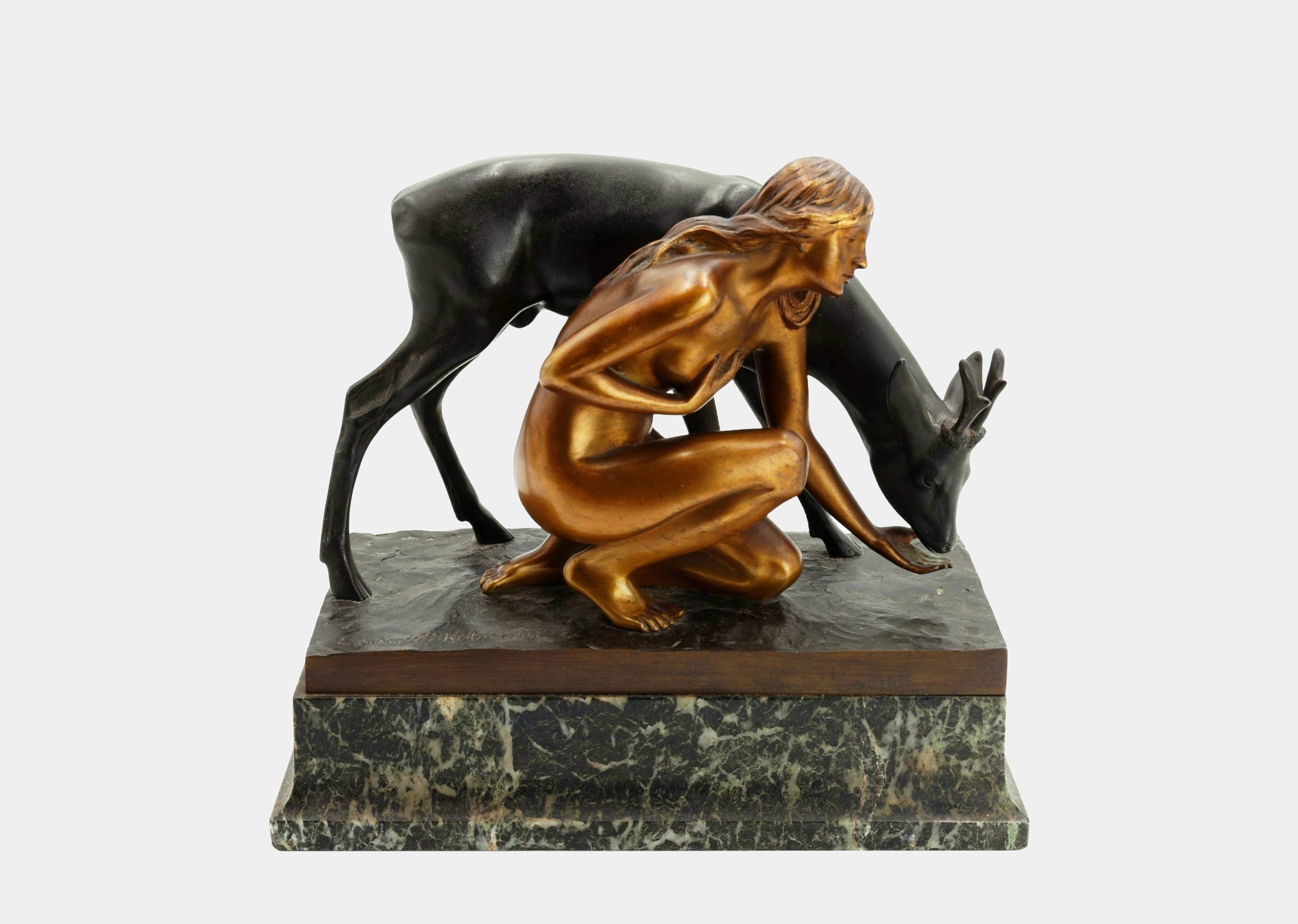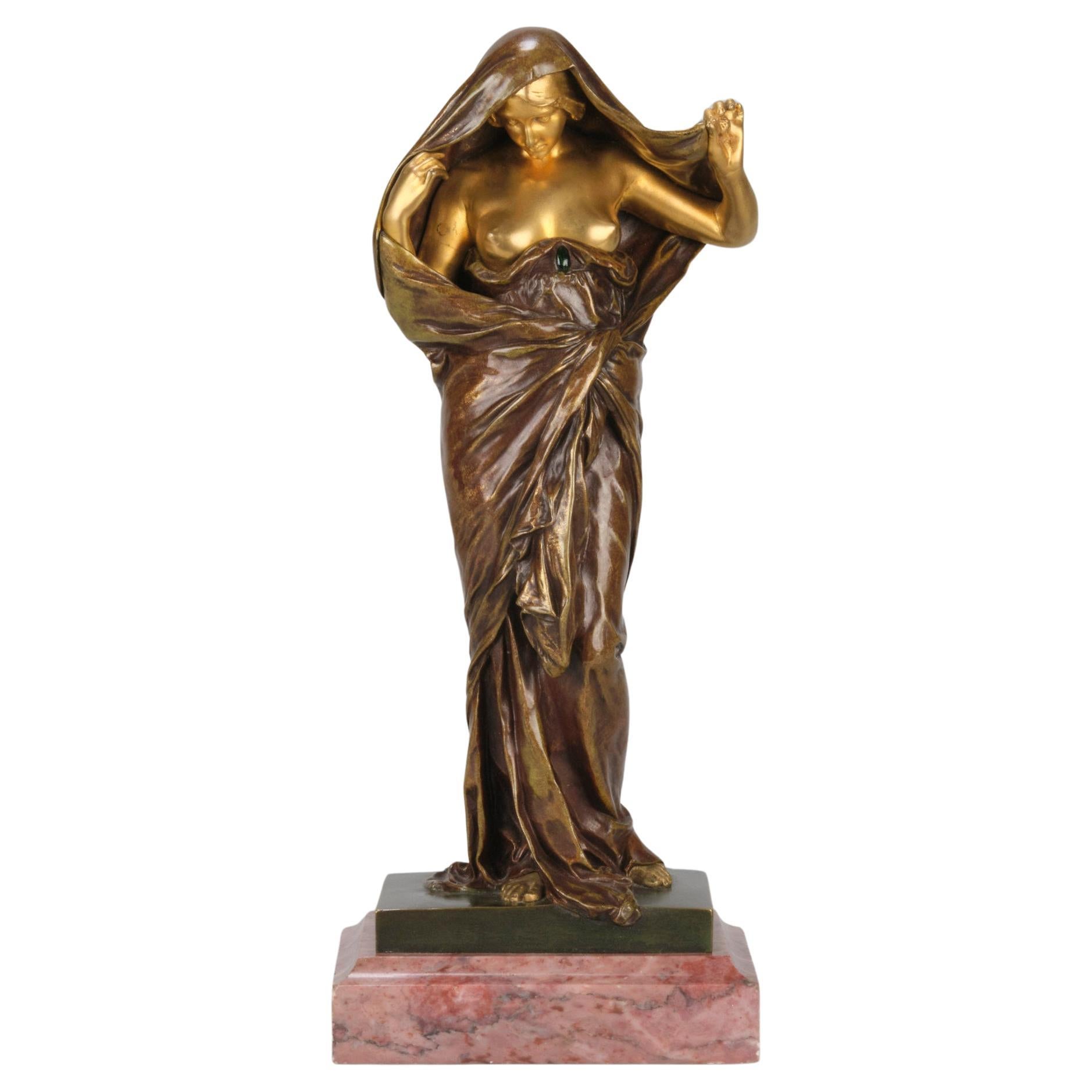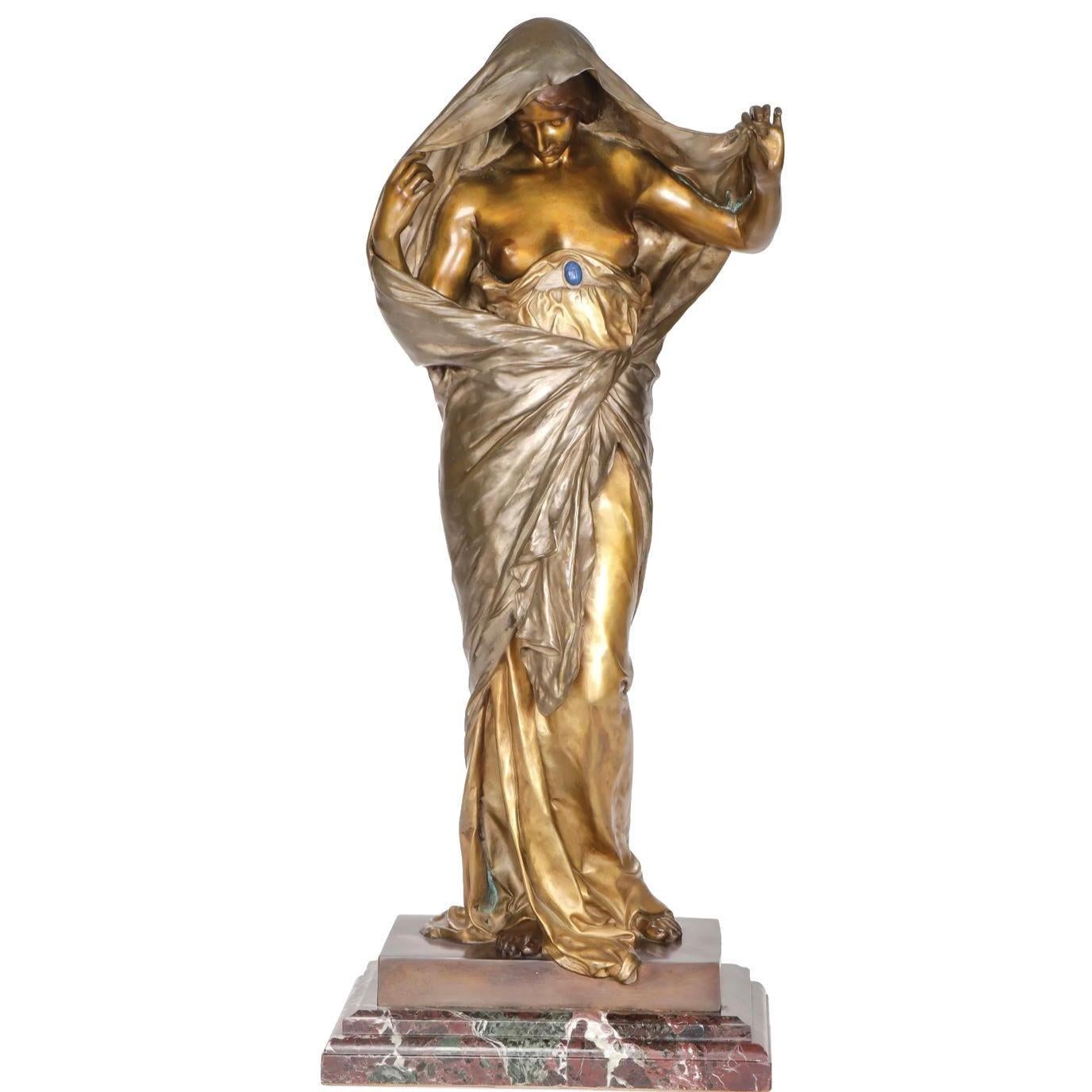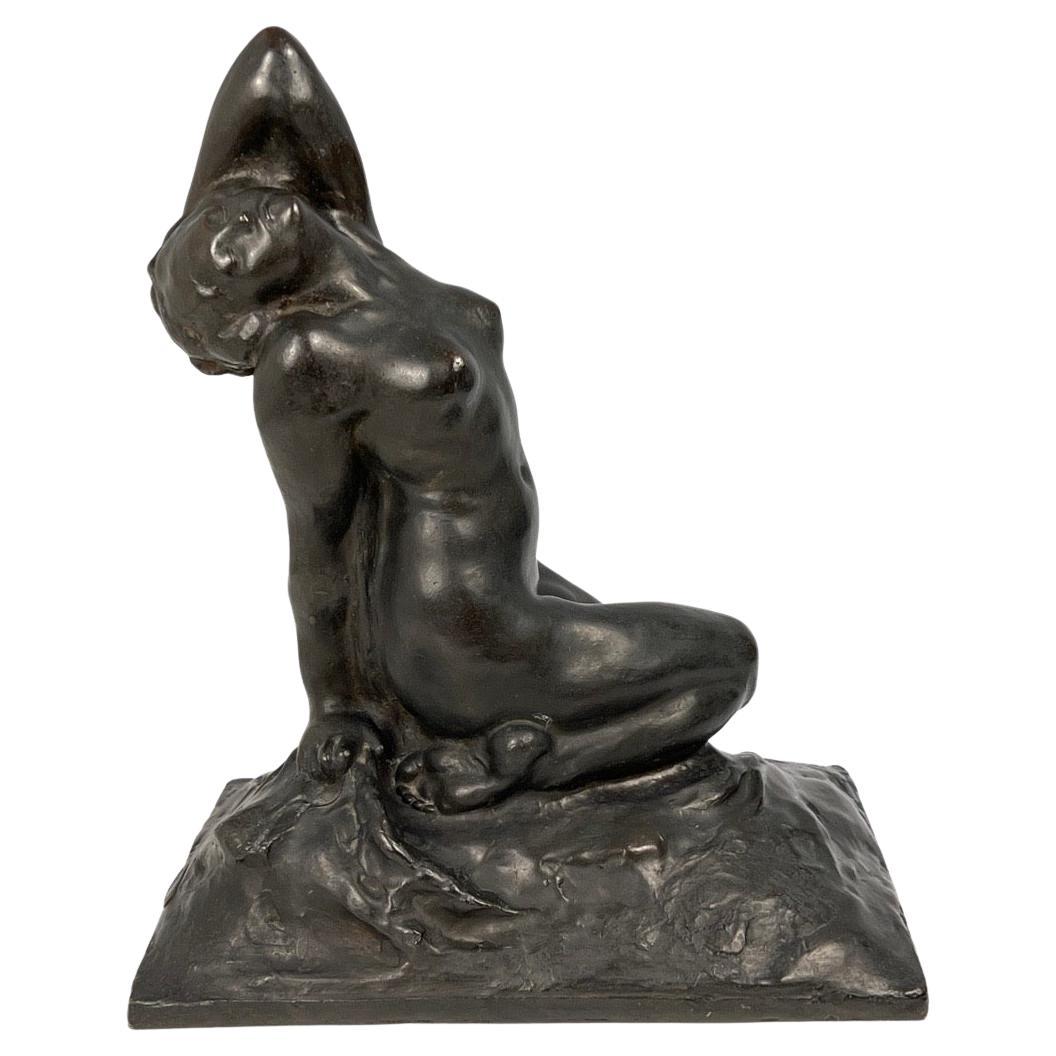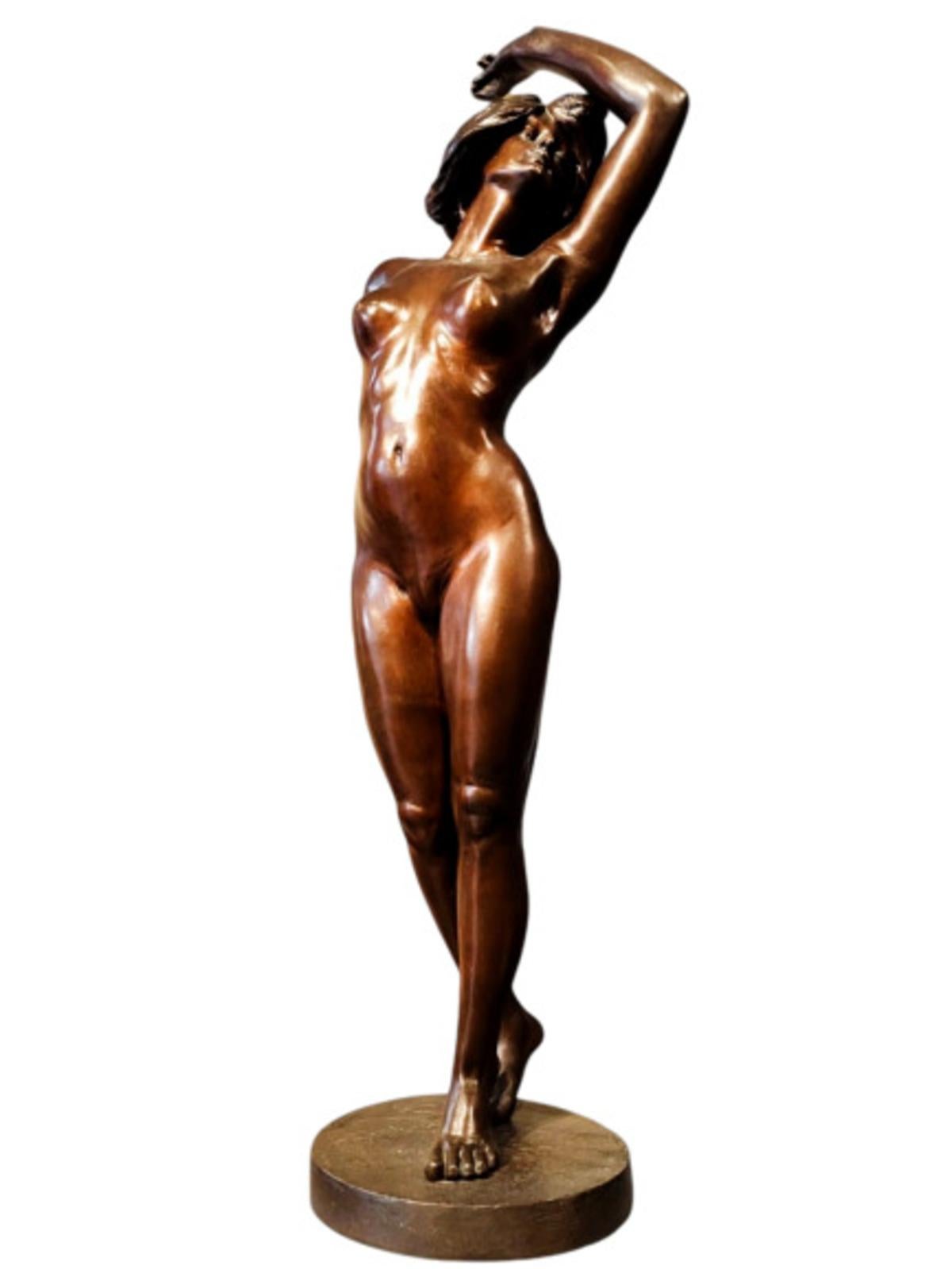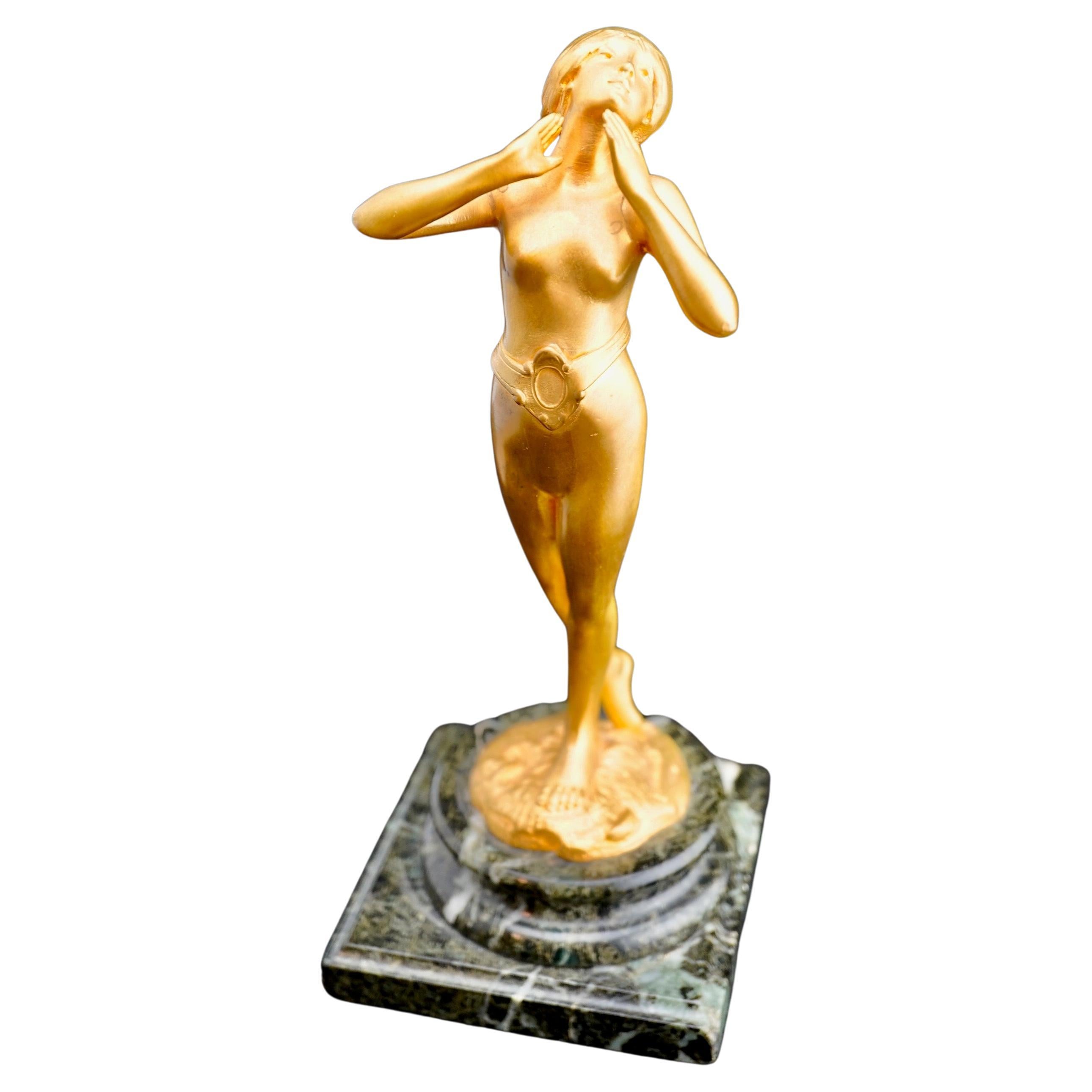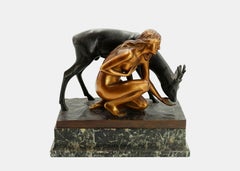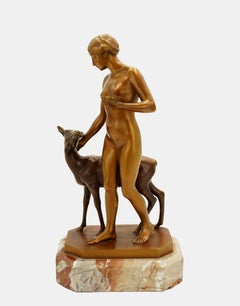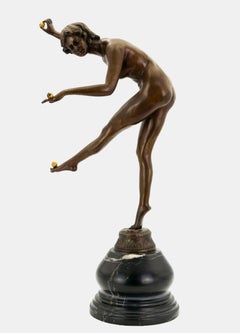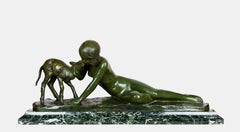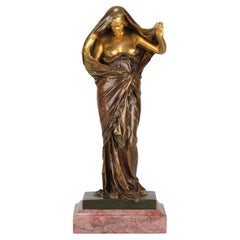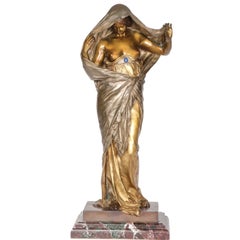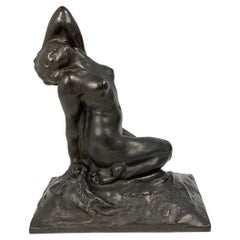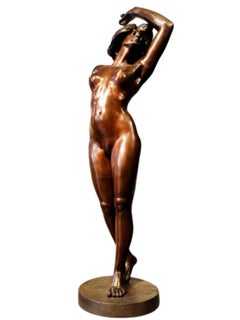Items Similar to Mother Happiness / - The ecstasy of maternal joy -
Want more images or videos?
Request additional images or videos from the seller
1 of 12
Johannes BoeseMother Happiness / - The ecstasy of maternal joy -c. 1910
c. 1910
$4,025.76
$5,032.2020% Off
£2,996.36
£3,745.4520% Off
€3,360
€4,20020% Off
CA$5,514.29
CA$6,892.8620% Off
A$6,133.09
A$7,666.3720% Off
CHF 3,202.51
CHF 4,003.1420% Off
MX$74,633.21
MX$93,291.5120% Off
NOK 40,900.94
NOK 51,126.1820% Off
SEK 38,357.87
SEK 47,947.3320% Off
DKK 25,578.51
DKK 31,973.1320% Off
Shipping
Retrieving quote...The 1stDibs Promise:
Authenticity Guarantee,
Money-Back Guarantee,
24-Hour Cancellation
About the Item
Johannes Boese (1856 Ostrog - 1917 Berlin), Mutterglück, um 1910. Goldbraun patinierte Bronze auf gegossener rechteckiger Plinthe, montiert auf zweifarbigem Marmorsockel (9,5 cm Höhe), Gesamthöhe 61 cm, Maße der Bronze: 50,5 cm (Höhe) x 18 cm (Länge) x 11,5 cm (Breite), Gewicht 12 kg, auf der Plinthe mit „J.[ohannes] Boese“ signiert und mit „Berlin“ ortsbezeichnet.
- Patina vereinzelt etwas berieben und leicht fleckig, Plinthe und Marmorsockel mit wenigen bestoßenen Stellen, eine Ecke alt restauriert.
- Die Ekstase mütterlicher Freude -
Hatte sich Johannes Boese vor allem der von staatlicher Seite in Auftrag gegebenen Monumentalplastik und repräsentativen Porträtdarstellungen gewidmet, veranschaulicht dieses Werk, dass der Künstler durchaus auch seinen eigenen Ideen folgte und, obwohl er bis zum Schluss dem von ihm mitgeprägten wilhelminischen Staatsstil folgte, sich auch vom Jugendstil inspirieren ließ.
Wir sehen eine ausschreitende Mutter, die voller Freude ihren Jungen in die Höhe hebt und beglückt in die Augen schaut. Das Kind erwidert den Blick mit derselben Innigkeit und streckt dabei eine Hand nach der Mutter aus. In den gespreizten Fingern zeigt sich das nicht erfüllte Verlangen, sie zu berühren und ihr dadurch ganz nahe zu sein. Mit seiner hohen Stirn und den breiten Wangenpartien wirkt der Junge wie ein säkularer Putto, was Boeses Herkunft aus dem wilhelminischen Barock verrät und der Darstellung eine allegorische Dimension verleiht. Mit der anderen Hand umklammert der Junge eine Puppe, was ihn durch und durch menschlich erscheinen lässt. Die ganz natürlich wirkenden Strampelbewegungen veranschaulichen ihn geradewegs als Inbegriff des kindlichen Kindes.
Das Antlitz der Mutter weist mit der gelängt-geraden Nase antikisierende Züge auf, während ihr Körper in antiker Nacktheit vor Augen steht, was der Skulptur auch von der Darstellung der Mutter her eine allegorische Dimension verleiht. Der Kontrapost der klassischen Skulptur mit seinem Stand- und Spielbein ist allerdings zum Ausschreiten geworden. Der in sich ruhenden Körper ist in eine beinahe stürmische Bewegung versetzt, die von einer inneren Bewegung getragen wird.
Die Skulptur erzählt eine Geschichte, deren Höhepunkt hier vor Augen steht: Die Mutter hat ihren Jungen von Weitem erblickt, ist auf ihn zugestürmt und hat in voller Freude und mütterlichem Stolz in den Himmel gehoben, während der Sohn von dem Gefühl erfüllt wird, endlich wieder bei seiner Mutter zu sein, die er ebenfalls liebkosen möchte.
Ist das Bild der Mutterschaft nicht zuletzt durch Maria mit dem Christuskind geprägt, so schafft Boese hier ein Bild der zur Mütterlichkeit gehörenden Freude, die gradewegs ekstatisch-tänzerische Züge annimmt, als ob die Mutter vor Glück einen im gezeigten Moment kulminierenden Freudentanz vollführen würde. Durch den Nachvollzug der verschiedenartigen Ansichten der Bronzeplastik wird die tänzerisch-ekstatische Bewegung vom Betrachter immer wieder neu initiiert.
Die Schönheit des naturalistisch herausmodellierten weiblichen Körpers strahlt das Mutterglück ab, das durch die goldfarbene Patina geradewegs zum Aufleuchten gebracht wird. Dabei geht der Eros ihrer nackten Schönheit ganz in der sie erfüllenden Freude über die Frucht ihres Leibes auf.
zum Künstler
Nach einer Ausbildung als Holzbildschnitzer besuchte Johannes Boese zunächst die Kunstgewerbeschule in Gleiwitz. Seinem eigentlichen Talent als Bildhauer folgend, ging er 1877 an die Berliner Kunstakademie und studierte dort bis 1883 bei Fritz Schaper und Albert Wolff, dessen Meisterschüler er wurde. Wolff gehörte zu den führenden Künstlern der von Johann Gottfried Schadow und seinem Schüler Christian Daniel Rauch begründeten Berliner Bildhauerschule.
Mit dem 1883 geschaffenen Werk Narcissus, das 1888 auf der Weltausstellung in Melbourne ausgezeichnet wurde, fand Boese erste Anerkennung. Es folgten größere Aufträge wie das 1885 entstandene Relief, „Empfang der Hugenotten durch den Großen Kurfürsten“, am Französischen Dom auf dem Gendarmenmarkt. 1887 schuf er mit Unterstützung einer Leselupe die in Bronze gegossene Statuette des Kaisers Wilhelms I., die von Wilhelm II. gleich in mehreren Exemplaren erworben wurde und Boese zu einem der Lieblingskünstler des Kaisers hat werden lassen, was ihm zahlreiche Staatsaufträge einbrachte. So durfte er, ohne am Bewerbungsverfahren teilnehmen zu müssen, die vierte Denkmalgruppe für die damals hoch renommierte Berliner Siegesallee schaffen. Sein 1898 vollendetes Standbild Albrechts II. in Begleitung von Eike von Repgow, dem Verfasser des Sachsenspiegels, und Hermann von Salza, dem bedeutendsten Hochmeister des Deutschen Ordens, ließ Boese zu einem der gefragtesten Staatskünstler werden. In der Folge schuf er vor allem Monumentalplastiken, die Potentaten des Herrscherhauses darstellten. Für sein 1902 in Posen errichtetes Denkmal Kaiser Friedrichs III. wurde Boese zum Professor an der Berliner Kunstakademie ernannt. Einer seiner Schüler war Georg Meyer-Steglitz, der ebenfalls Monumentalwerke schuf, die heute allerdings weitgehend verloren sind.
GERMAN VERSION
Johannes Boese (1856 Ostrog - 1917 Berlin), Mother Happiness, around 1910. Gold-brown patinated bronze on a cast rectangular plinth, mounted on a two-tone marble base (9.5 cm high), total height 61 cm, dimensions of the bronze: 50.5 cm (height) x 18 cm (length) x 11.5 cm (width), weight 12 kg, signed on the plinth "J.[ohannes] Boese" and inscribed with "Berlin".
- Patina somewhat rubbed and slightly stained in places, plinth and marble base with some dents, one corner restored.
- The ecstasy of maternal joy -
While Johannes Boese had devoted himself primarily to monumental sculptures commissioned by the state and representative portraits , this work illustrates that the artist also followed his own ideas and, although he followed the Wilhelmine state style, he was also inspired by Art Nouveau.
We see a mother striding out, joyfully lifting her boy into the air and gazing happily into his eyes. The child returns the gaze with the same intimacy, extending a hand toward the mother. The spread fingers show the unfulfilled desire to touch her. With his high forehead and broad cheeks, the boy looks like a secular putto, betraying Boese's Wilhelminian Baroque origins and adding an allegorical dimension to the depiction. With his other hand, the boy clutches a doll, making him appear thoroughly human. The natural-looking kicking movements illustrate him as the epitome of the childlike child.
The mother's face, with its elongated, straight nose, has antique features, while her body stands before us in antique nudity, which also gives the sculpture an allegorical dimension in terms of the representation of the mother. However, the contrapposto of classical sculpture, with its supporting and free leg, has become an extension. The body, resting in itself, is set in an almost tempestuous motion, carried by an inner movement.
The sculpture tells a story, the climax of which can be seen here: The mother has seen her son from afar, rushes to him and lifts him up to the sky with joy and maternal pride, while the son is filled with the feeling of finally being with his mother again, whom he also wants to caress.
If the image of motherhood is characterized not least by Mary with the Christ Child, Boese creates here an image of the joy that belongs to motherhood, which takes on ecstatic, dance-like traits, as if the mother were performing a dance of joy that culminates in the moment shown. By tracing the different views of the bronze sculpture, the dancing, ecstatic movement is continually reinitiated by the viewer.
The beauty of the naturalistically modeled female body radiates maternal happiness, which is made to glow by the golden patina. The eros of her naked beauty is completely absorbed in the joy of the fruit of her womb.
About the artist
After training as a woodcarver, Johannes Boese first attended the School of Arts and Crafts in Gliwice. Following his real talent as a sculptor, he entered the Berlin Academy of Art in 1877 and studied there until 1883 under Fritz Schaper and Albert Wolff, whose master student he became. Wolff was one of the leading artists of the Berlin School of Sculpture, founded by Johann Gottfried Schadow and his pupil Christian Daniel Rauch.
Boese received his first recognition with the 1883 work Narcissus, which won a prize at the 1888 World's Fair in Melbourne. Larger commissions followed, such as the 1885 relief "Reception of the Huguenots by the Great Elector" in the French Cathedral at the Gendarmenmarkt. In 1887, with the aid of a reading magnifier, he created the bronze statue of Emperor Wilhelm I. Several copies were purchased by Wilhelm II, making Boese one of the emperor's favorite artists and earning him numerous state commissions. For example, he was allowed to create the fourth group of monuments for Berlin's then famous Victory Avenue without having to take part in the competition. His statue of Albrecht II in the company of Eike von Repgow, the author of the Saxon Mirror, and Hermann von Salza, the most important Grand Master of the Teutonic Order, completed in 1898, made Boese one of the most sought-after state artists. In the following years he mainly created monumental sculptures depicting potentates of the ruling dynasty. For his monument to Emperor Frederick III, erected in Posen in 1902, Boese was appointed professor at the Berlin Academy of Art. One of his students was Georg Meyer-Steglitz, who also created monumental works, most of which are now lost.
- Creator:Johannes Boese (1856 - 1917, German)
- Creation Year:c. 1910
- Dimensions:Height: 24.02 in (61 cm)Width: 7.09 in (18 cm)Depth: 4.53 in (11.5 cm)
- Medium:
- Movement & Style:
- Period:
- Condition:
- Gallery Location:Berlin, DE
- Reference Number:1stDibs: LU2438215077772

About the Seller
5.0
Gold Seller
Premium sellers maintaining a 4.3+ rating and 24-hour response times
Established in 2014
1stDibs seller since 2023
20 sales on 1stDibs
- ShippingRetrieving quote...Shipping from: Berlin, Germany
- Return Policy
Authenticity Guarantee
In the unlikely event there’s an issue with an item’s authenticity, contact us within 1 year for a full refund. DetailsMoney-Back Guarantee
If your item is not as described, is damaged in transit, or does not arrive, contact us within 7 days for a full refund. Details24-Hour Cancellation
You have a 24-hour grace period in which to reconsider your purchase, with no questions asked.Vetted Professional Sellers
Our world-class sellers must adhere to strict standards for service and quality, maintaining the integrity of our listings.Price-Match Guarantee
If you find that a seller listed the same item for a lower price elsewhere, we’ll match it.Trusted Global Delivery
Our best-in-class carrier network provides specialized shipping options worldwide, including custom delivery.More From This Seller
View AllThe Feeding / - Natural grace -
Located in Berlin, DE
Erich Schmidt-Kestner (1877 Berlin - 1941 Nordhausen), The Feeding, around 1915. Gold and black patinated bronze with cast brown patinated plinth mounted on a lightly veined black-gr...
Category
1910s Art Nouveau Nude Sculptures
Materials
Bronze
$4,313 Sale Price
20% Off
Forest idyll / - Soulmate -
By Rudolf Kaesbach
Located in Berlin, DE
Rudolf Kaesbach (1873 Gladbach - 1955 Berlin), Forest idyll, around 1915. Bronze, gold and golden brown patina, with cast plinth, mounted on a marble base (5 cm high), total height 36 cm, dimensions of the bronze: 31 cm (height) x 17 cm (length) x 12 cm (width). Weight 4,6 kg, signed on the plinth "R.[udolf] KAESBACH".
- a few rubbed areas, overall in excellent condition for its age
- Soulmate -
The bronze sculpture depicts a young woman in an intimate exchange with a deer that accompanies her. The animal pauses to turn toward her, while the nude beauty slows her pace to look into the deer's eyes and tenderly caress it with her hand. The woman and the deer are in inner harmony. Even though her lips remain motionless, she speaks the language of the animal with which she is deeply connected.
The golden patina, which contrasts with the more naturalistic coloring of the deer, gives the young woman the appearance of a saint, even if she cannot be identified as such. At the same time, she evokes memories of Diana, the goddess of the hunt, or a nymph. But she lacks the ferocity. In her innocent naivety, she is more like a vestal virgin, who is not at home in the solitude of the forest. And yet, the young beauty, moving unclothed in the heart of nature, looks like a priestess with her hair tied up and a carefully carried bowl on her way to a sacred grove.
In order to open up the above-mentioned associations, Kaesbach deliberately designed the female figure in such a way that she cannot be identified as a specific person. He has created an allegory of natural femininity, characteristic of Art Nouveau, in which the deer is far more than a companion animal. It displays the same gracefulness as the young woman, and the inner resemblance between the two makes the deer appear as her other self. In animal terms, it embodies her inner being, which also gives the deer an allegorical character.
About the artist
Rudolf Kaesbach studied sculpture at the Hanau Academy and worked in a bronze foundry in Paris in 1900. In order to work as an independent artist, he opened a workshop in Düsseldorf, where he cast bronzes from models he designed. In 1902 he made his debut at the German National Art Exhibition in Düsseldorf. The following year Kaesbach went to the academy in Brussels. There he was inspired by contemporary Belgian sculpture, especially the work of Constantin Meunier. He moved to Berlin, where he opened a studio in the villa district of Grunewald and devoted himself to life-size marble sculptures and the design of bronzes. From 1911, he regularly presented his works at the major art exhibitions in Berlin, as well as in Düsseldorf and Malmö. Between 1936 and 1939, he also created models for the Rosenthal porcelain factory. From 1939 to 1944, Kaesbach was represented at the major German art exhibitions in Munich.
GERMAN VERSION
Rudolf Kaesbach (1873 Gladbach - 1955 Berlin), Waldidyll, um 1915. Gold und goldbraun patinierte Bronze mit gegossener Plinthe, auf einem Marmorsockel montiert (5 cm Höhe), Gesamthöhe 36 cm, Maße der Bronze: 31 cm (Höhe) x 17 cm (Länge) x 12 cm (Breite). Gewicht 4,6 kg, auf der Plinthe mit „R.[udolf] KAESBACH“ signiert.
- vereinzele beriebene Stellen, insgesamt in einem altersgemäß ausgezeichneten Zustand
- Seelenverwandtschaft -
Die Bronzeplastik veranschaulicht eine junge Frau im innigen Austausch mit einem sie begleitenden Reh. Das Tier hält inne, um sich zu ihr hochzuwenden, während die nackte Schönheit ihren Schritt verlangsamt, um dem Reh ebenfalls in die Augen zu schauen und es zärtlich mit der Hand zu liebkosen. Die Frau und das Reh sind in einem inneren Gleichklang. Auch wenn ihre Lippen unbewegt bleiben, spricht sie die Sprache des Tieres, mit dem sie auf eine tief empfundene Weise verbunden ist.
Die im Kontrast zur naturalistischeren Einfärbung des Rehs aufstrahlende goldfarbene Patina lässt die junge Frau wie eine Heilige erscheinen, auch wenn sich nicht als Heilige identifizierbar ist. Zugleich ruft sie Erinnerungen an die Jagdgöttin Diana oder eine Nymphe hervor. Dafür fehlt ihr allerdings die Wildheit. In ihrer unschuldigen Naivität gemahnt sie vielmehr an eine Vestalin, die freilich nicht in der Waldeinsamkeit zu Hause ist. Und doch wirkt die sich unbekleidet im Herzen der Natur bewegende junge Schönheit wie eine Priesterin, die sich mit hochgebundenem Haar und der vorsichtig getragenen Schale und dem Wege zu einem Heiligen Hain befindet.
Um die gennannten Assoziationen zu eröffnen, hat Kaesbach die Frauenfigur bewusst so gestaltet, dass sie nicht als konkrete Person identifizierbar ist. Damit hat er eine für den Jugendstil charakteristische Allegorie natürlicher Weiblichkeit geschaffen, bei der das Reh weit mehr als ein Begleittier ist. Es weist dieselbe grazile Anmut wie die junge Frau auf und der innere Gleichklag der beiden lässt das Reh als ihr anderen Ich erscheinen. Es verkörpert – ins Animalische übertragen - ihr inneres Wesen, wodurch auch dem Reh ein allegorischer Charakter zukommt.
zum Künstler
Rudolf Kaesbach studierte an der Akademie Hanau Bildhauerei und war im Jahr 1900 in einer Pariser Bronzegießerei tätig. Um sich als eigenständiger Künstler betätigen zu können, eröffnete er in Düsseldorf eine Werkstatt, in der er Bronzen nach selbstentworfenen Modellen goss. 1902 debütierte er auf der Deutschen Nationalen Kunstaustellung in Düsseldorf. Im Folgejahr ging Kaesbach an die Akademie nach Brüssel. Dort wurde er von der zeitgenössischen belgischen Bildhauerei, insbesondere vom Werk Constantin Meuniers, inspiriert. Zurückgekehrt zog er nach Berlin, wo er im Villenviertel Grunewald ein Atelier eröffnete und sich neben dem Entwurf für Bronzen der lebensgroßen Marmorbildhauerei widmete. Ab 1911 präsentierte er seine Werke regelmäßig auf den Großen Berliner Kunstausstellungen, aber auch in Düsseldorf und Malmö. Zwischen 1936 und 1939 fertigte er zudem Modelle für die Porzellan-Manufaktur Rosenthal an. Von 1939 bis 1944 war...
Category
1910s Jugendstil Nude Sculptures
Materials
Bronze
$4,024 Sale Price
20% Off
Juggler / - Artistic naturalness -
Located in Berlin, DE
Claire Jeanne Robertine Colinet (1880 Brussels - 1950 Asnières-sur-Seine), Juggler, around 1920. Brownish patinated bronze with gilded balls on a round, multi-profiled stone base (10...
Category
1920s Art Deco Nude Sculptures
Materials
Bronze
Girl with a Kid / - Caresses of innocence -
By Ary Bitter
Located in Berlin, DE
Ary Bitter (1883 Marseille - 1973 Paris), Girl with Kid, around 1930. Green patinated bronze with cast plinth loosely mounted on a white-veined dark green marble base. Dimensions of the plinth: 5 cm (height) x 80 cm (length) x 24 (width), dimensions of the bronze 28 cm (height) x 72 cm (length) x 18 cm (width). Weight of the bronze 18.2 kg, total weight 39.2 kg. Signed “Ary Bitter.” on the plinth and stamped “L N Paris J L” by the foundry Les Neveux de Jacques Lehmann...
Category
1930s Art Deco Nude Sculptures
Materials
Bronze
$8,626 Sale Price
20% Off
Psyche / - Fulfilled longing -
Located in Berlin, DE
Jan Jozef Jaquet (1822 Antwerp - 1898 Brussels), Psyche, 1847. Black-brown and brown patinated bronze on a cast base. 30 cm (height) x 22 cm (width) x 12 cm (depth), weight 5 kg. Ver...
Category
1840s Realist Figurative Sculptures
Materials
Bronze
$1,437 Sale Price
20% Off
Bust of a young woman / - The Opulence of Beauty -
Located in Berlin, DE
Anton Nelson (i.e. Antoine Joseph van den Kerckhoven) (1849 Brussels - after 1910 ibid.), Bust of a young woman, c. 1890. Patinated bronze on cast base, 30 cm (total height) x 20 cm ...
Category
1890s Art Nouveau Figurative Sculptures
Materials
Bronze
You May Also Like
Late 19th Century Art Nouveau Sculpture "Nature Unveiling" by Ernst Barrias
Located in London, GB
Wonderful late 19th Century Art Nouveau French bronze figure of a seductively draped female figure representing, in allegorical form, Nature revealing her secrets to Science, a fitti...
Category
Antique Late 19th Century French Art Nouveau Figurative Sculptures
Materials
Marble, Bronze
Louis Ernest Barrias Nature Revealing Herself
By Louis Ernest Barrias
Located in Dallas, TX
Louis Ernest Barrias (French 1841-1905)
Nature Revealing Herself
La Nature se dévoilant devant la Science
Gilt, and silver patinated bronze with blue glass scarab
Signed on base “E...
Category
Early 1900s Art Nouveau Figurative Sculptures
Materials
Bronze
Art Deco sculpture Ecstasy by Amadeo Gennarelli
By Amadeo Gennarelli
Located in Miami, FL
The Ecstasy Art Deco sculpture is one of the Italian sculptor, Amedeo Gennarelli, nude female figures. This is sculpture is made in Patinated Bronz...
Category
20th Century French Art Deco Figurative Sculptures
Materials
Bronze
Georges Flamand Bronze Danseuse (c. 1900–1910)
Located in Gent, VOV
This elegant and finely balanced bronze sculpture by Georges Flamand (1866 – ca. 1931) represents a Danseuse—a female dancer poised in a moment of lyrical movement, one arm arching g...
Category
20th Century Art Deco Nude Sculptures
Materials
Bronze
Art Nouveau Gilt Bronze Female Nude Statue by Georges Flamand.
By Georges Flamand
Located in Sarasota, FL
Art Nouveau gilded bronze nude statue by George Flamand. Very fine period work. Sits on 3 3./4" square base. Signed "FLAMAND"
Category
Antique Late 19th Century French Art Nouveau Figurative Sculptures
Materials
Gold Plate, Bronze
Rudolf KAESBACH (1873-1955) Bronze Jugendstil
By Rudolf Kaesbach
Located in Berlin, DE
Rudolf KAESBACH (1873-1955), "Snake Charmer"
Inscribed 'R. Kaesbach' on the plinth and with the foundry mark, height with base: approx. 30.2 cm
Founding mark RM
Rosenthal & Maeder ...
Category
Early 20th Century Figurative Sculptures
Materials
Bronze
More Ways To Browse
Art Plinth
Marble Sculpture Nude
Antique Bronze Nude
Art Nouveau Bronze Germany
Art Nouveau Marble Sculptures
Marble Fruit Sculptures
Bronze Nude Dancer
Relief Sculpture Face
Putto Sculpture
Art Nouveau Bronze Female
Gold Mirror Art Nouveau
Nude Marble Statue
Art Nouveau Bronze Nude
Bronze Fruit Sculpture
Female Nude Art Nouveau
Bronze Statue Germany
Bronze Female Statue France
Victory Statue
